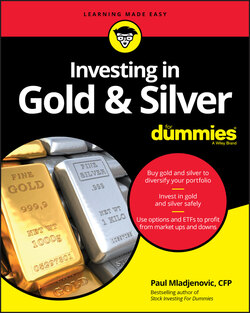Читать книгу Investing in Gold & Silver For Dummies - Paul Mladjenovic, Paul Mladjenovic, Ted Sudol - Страница 60
Gold versus stocks versus currencies
ОглавлениеYou see in the prior section how gold was the 800-pound gorilla in the battle royale versus other mainstream investment vehicles, but it’s important to measure gold versus its primary competitors such as stocks and currencies. In this, you’re comparing “apples to apples.”
When you’re comparing gold to stocks, for example, I don’t advocate that you should be 100 percent in one or another. I could put on my “stock hat” and make a strong case for stocks in some economic conditions (such as the 1980s), and I could put on my “gold hat” and make the case that gold is superior in other conditions (such as 2020–2025).
The bottom line is I think both stocks and gold are important and needed in your portfolio. The only thing is that you rebalance the percentages of your portfolio between regular stocks and gold-related investments. You keep more in stocks when times are good for stocks and more in gold when times are good for gold. But always have something in gold (say 2 to 5 percent of your investable assets at a minimum), even when it’s not doing as well because it excels as a hedge and a backup form of “portfolio insurance.” Sometimes you don’t see the market crash or financial crisis coming, and afterward, you’ll be glad you were diversified and had some gold and/or silver on hand.
Gold plays an important role as money and as a hedge against the issues of government-issued money, which is also referred to as fiat money. As I write this book, all the major currencies — the U.S. dollar, the euro, the British pound, the yuan, the Japanese yen, and other currencies — are losing their value (depreciating) slowly but surely. Some currencies are rapidly losing their value, such as those in Venezuela, Zimbabwe, and Argentina (more to come!). The main reason currencies lose their value is because they can easily be overproduced by the country’s central bank and typically at the behest of the country’s political leaders.
Because paper currencies are easily inflated, each unit of currency (dollar, euro, yen, and so on) loses value — not so for gold. As the data from the World Gold Council (WGC) confirms, the mining of gold typically adds about 2 percent to the above-ground global supplies of gold. It’s very difficult to extract it from the earth, which is part of the reason gold can retain its value versus central bank–issued currencies. You can use this chapter to find out how gold stacks up as a tangible investment amidst all the investment choices available today.
Part of what makes “money” retain value is scarcity. If it ceases to be scarce and easily created (usually leading to overcreating it), then this leads to its diminishing value. Some gold experts even make it a big point of their speeches that a paper/digital currency will always revert to its intrinsic value, which is “zero.” Gold, meanwhile, outlived every currency in the past two millennia and likely will do so in this millennium. As I write this (August 2020), we’re in the early stages of a precious metals bull market.
